Fine Egg Noodles Recipe as Good as Grandma Used To Make
Sneak Preview: These Fine Egg Noodles are made with a food processor and a simple hand-crank pasta machine. Even though Grandma made hers by hand, these are every bit as delicious and much simpler. Perfect for Thanksgiving dinner.
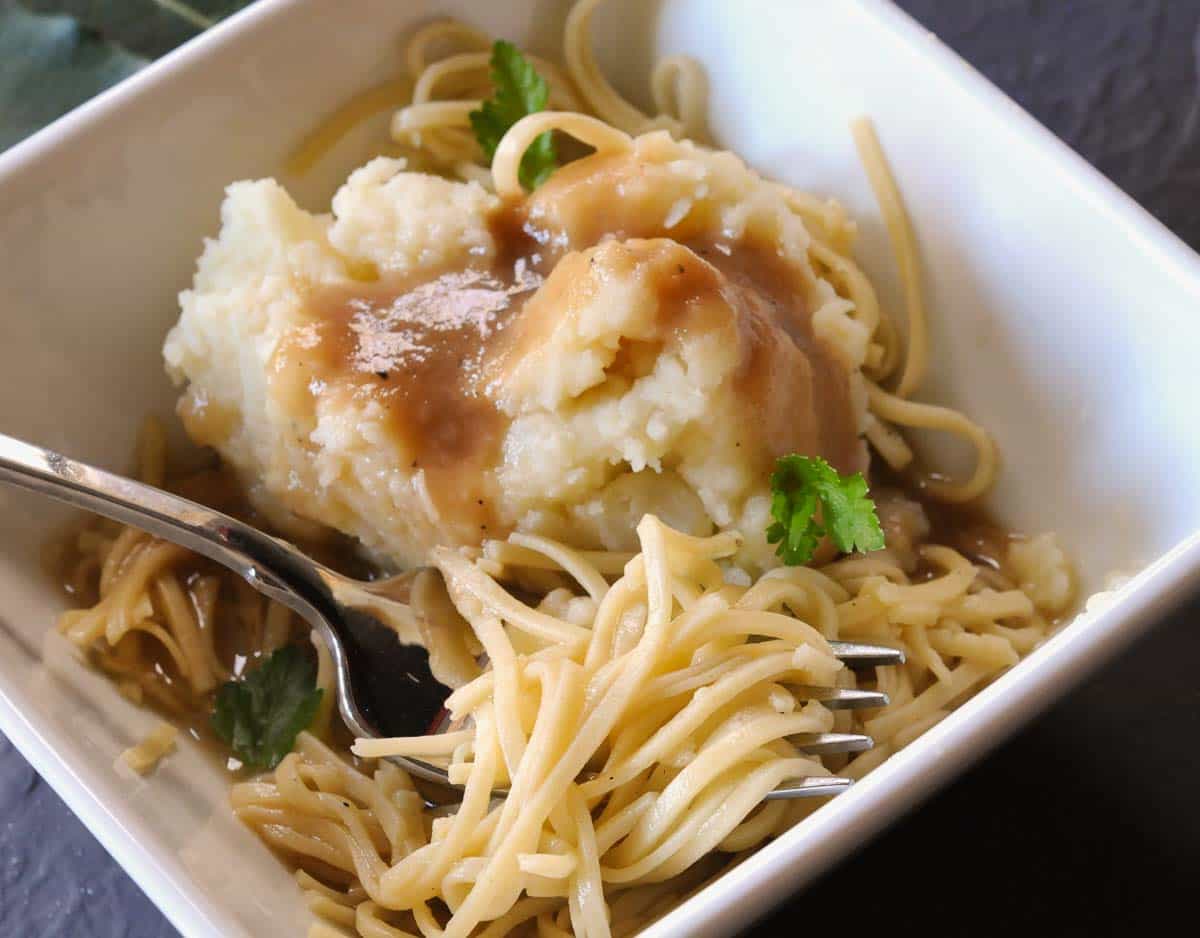
As an Amazon Associate, I earn from qualifying purchases.
My grandma made her famous thin noodles from scratch. I can still picture her wearing a full-length apron over a simple cotton dress with her long gray hair twisted into a bun. Her work area was an aqua-colored
Grandma’s hand-mixed dough submitted to her silver-handled rolling pin with little resistance. After the noodle sheets dried, she cut wide strips and stacked them. Finally, she cut each stack crosswise into slivers she described as “thin as frog’s hair.” When asked her secret to great noodles, I remember her saying, “It’s all in the broth.”
Happy Cooks Speak Up
“I am sure saliva is dripping down my chin right now… I sure hope my mom comes through with the noodles for Christmas dinner!
This post seems extra special…I love your sweet memories that originated in the kitchen! I am imagining Ellie having very similar memories with Grandma Kay.
Perfect Christmas post!!!!!!!!!!!!!”—DER
Why Make Skinny or Fine Egg Yolk Noodles?
TRADITION!
And they taste outstanding, too. The texture of these fresh egg noodles can best be described as tender and delicate.
Here’s the problem…
In our family, the noodle recipe is controversial. I asked around but could find no consensus.
Aunt Marg says the best noodles come from using only egg yolks, cake flour, a dab of cream, and salt. That formula would result in some very tender noodles, but she didn’t specify the amounts.
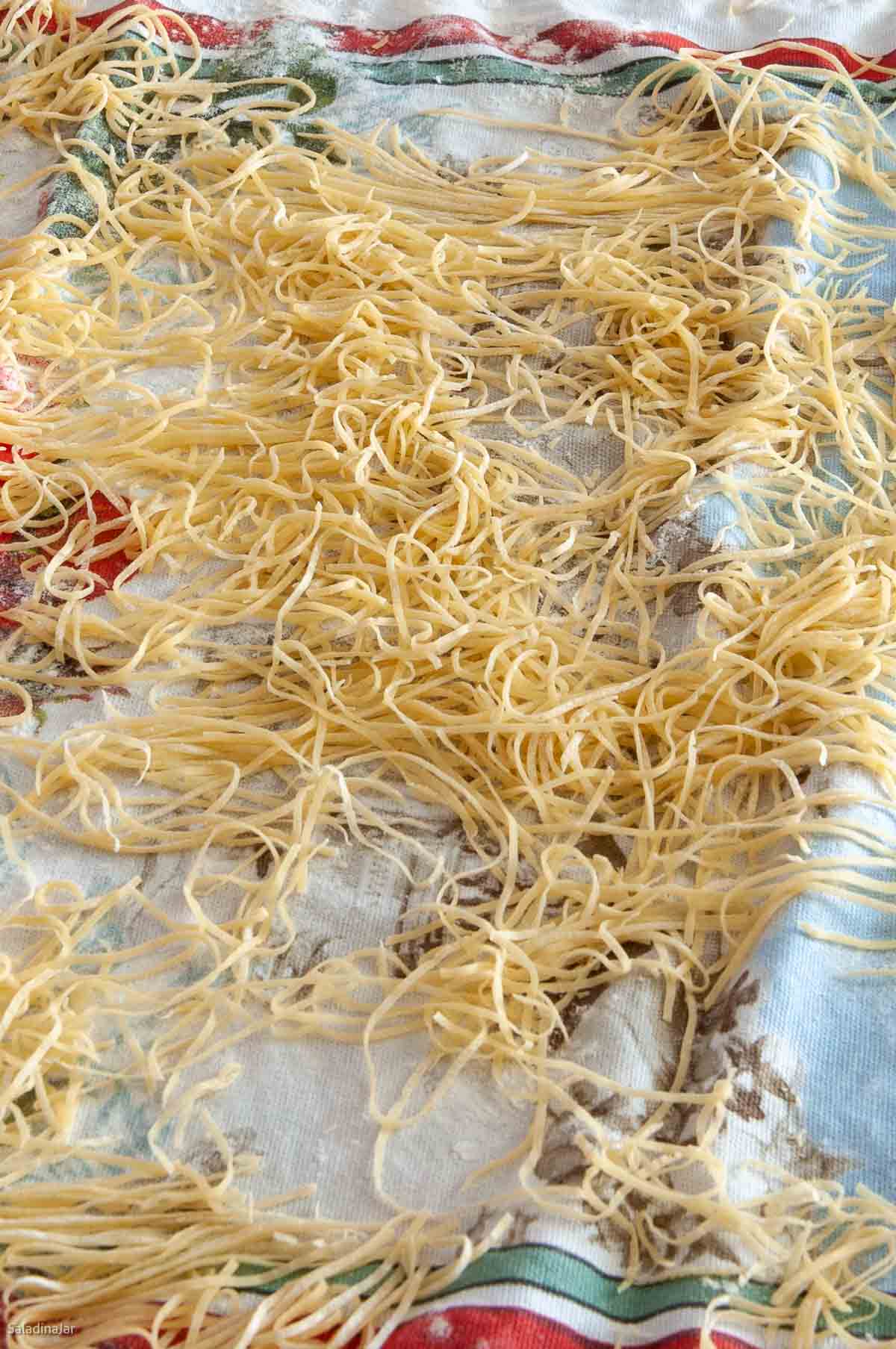
Ingredients and Substitutions
- FLOUR: The recipe specifies all-purpose flour. My aunt used cake flour. Please note that you are not going for chewy or springy noodles, such as you would serve with spaghetti. A high-protein flour (such as bread or whole wheat) would make chewier noodles.
- SALT: Any kind of salt is fine. You don’t need much. However, the broth should be well-seasoned with salt.
- BAKING POWDER: The baking powder is an obscure detail I remember copying from my best friend’s recipe book. Maybe Gran gave her some insider information, or perhaps it was her mother’s recipe. I’m not sure. At any rate, it can be omitted if you prefer. I think it gives the noodles a touch of lightness.
- EGG YOLKS: Using egg yolks only will make rich and deeply colored noodles. If you prefer, use one egg and one yolk for lighter-colored noodles that aren’t quite as rich.
- HEAVY CREAM: Substitute whole milk for cream if you don’t have it. Your noodles won’t be as rich, but they will still taste fabulous.
- STOCK: My first choice would be freshly made turkey or chicken broth. Substitute canned broth, bouillon paste, or bouillon cubes if nothing else is available.
How To Serve Fine Egg Noodles
One thing we agree about is how to eat these noodles. Serve and eat skinny egg noodles with mashed potatoes and gravy. If that doesn’t sound good, I’m guessing you aren’t a Midwesterner. No problem. Add some chicken or beef and plenty of quality broth. You’ll love them.
Variation
If chicken stock isn’t your favorite, try cooking these noodles in beef stock. That’s the way my sister-in-law does it. She also cuts wider noodles that aren’t quite as thin. Her grown grandkids go crazy for them.
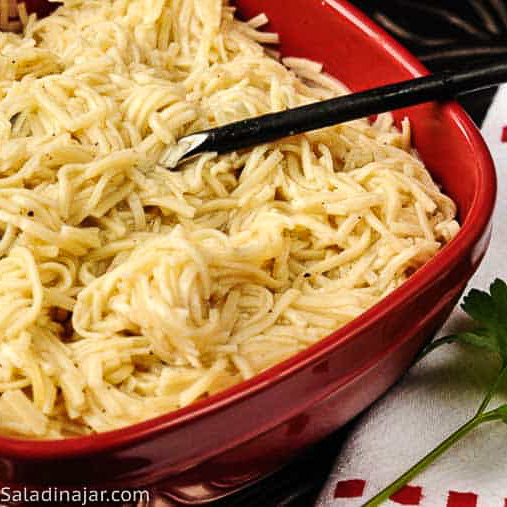
What You Should Know About Making Homemade Thin Egg Noodles
1. You can mix, roll, and cut these by hand, but I prefer a simple noodle machine.
A pasta machine will produce noodles much skinnier than I can cut. With that in mind, the directions on this post are for a noodle machine. Grandma would have nothing to do with a machine.
2. Your noodles will be no better than your stock. Grandma said so.
My favorite way to prepare chicken stock is to put the bones of a rotisserie chicken into a slow cooker overnight. You could try the recipe I use for my Chicken and Dumplings, but I would leave out the lemon juice.
3. Don’t be deceived by the small amount of dough this recipe produces.
This dough has a way of “birthin’ babies.” You will begin to think you won’t finish cutting noodles before Santa drops down the chimney.
This recipe makes enough for 4-5 people or even more if there’s a lot of other food, such as Thanksgiving. I usually make two batches for a big family gathering.
4. Don’t throw out the egg whites with the shells.
Grandma and my sister-in-law, Susan, always make angel food cake with leftover egg whites. If you like that idea, here are a few ideas: Espresso Angel Food Cake, Chocolate and Vanilla Angel Food Cake with Dipped Cone Ising, Snowball Cake
How To Mix the Dough in a Food Processor
Add flour to the food processor bowl along with salt and baking powder. Pulse several times to mix. Add egg yolks and half of the cream to dry ingredients and process until the texture of cornmeal.
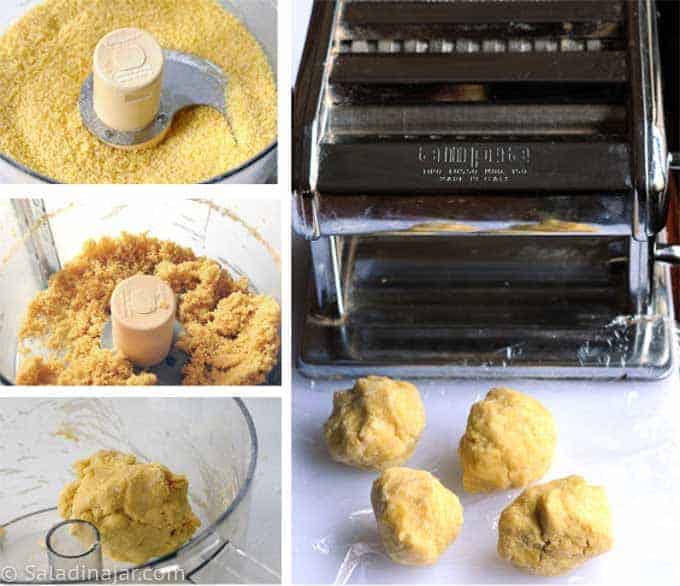
Gradually add the rest of the cream by dripping it until the mixture is damp enough to stick together when pressed with your hand. It should not be wet or excessively sticky.
Knowing when you’ve added the right amount of liquid takes some experience best learned from your own mistakes or while watching over Grandma’s shoulder. If necessary, add more flour or cream/milk if needed.
By the way, while you have your food processor out on the counter, you might as well think about whipping out some homemade mayonnaise or this extraordinary glazed chocolate cake.
How To Roll Out Skinny Noodle Dough
First: Use your fingers to press the dough into a ball and remove it from the bowl. Cover and allow to rest for 10+ minutes. Next, divide the dough into four sections. Smash each section into a flat pancake with the palm of your hand on a floured board. It’s OK, even advisable, to be liberal with the flour.
Kneading the dough
Second: Set the noodle machine thickness to 1 and roll one dough patty between the smooth rollers. Fold over and put through the machine again.
Repeat the process 4-5 times until the dough sheet is smooth and shiny. Do this with each patty.
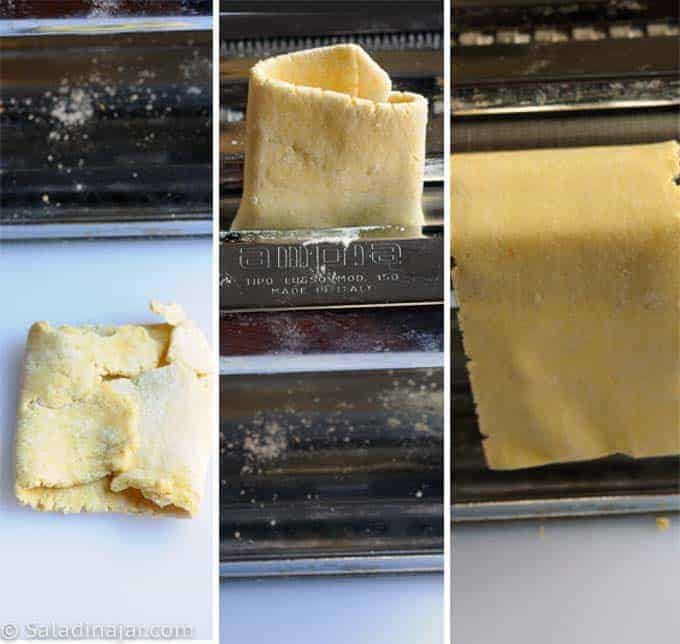
Although this sounds time-consuming, it goes fast once you get the hang of it.
Set the thickness of the smooth rollers on #2 and roll each sheet through once or twice, tugging slightly on the dough as you pull it through. Keep moving the roller thickness up a notch and repeat the process. I like my noodles as thin as possible, so I go to 5 or 6 on my machine.
Use flour whenever necessary to keep the dough from sticking along the way. As dough strips get thinner, they get longer. Cut in half crosswise as needed.
Cutting the noodles
Third: When noodles reach your desired thinness, lay them out to rest and dry. There should be no overlap between the strips. After the noodles are dry enough (again,
Feed strips through the fine noodle cutter. Noodles should NOT stick together as they come out of the cutter. If they do, allow the dough to dry or dust it with more flour.
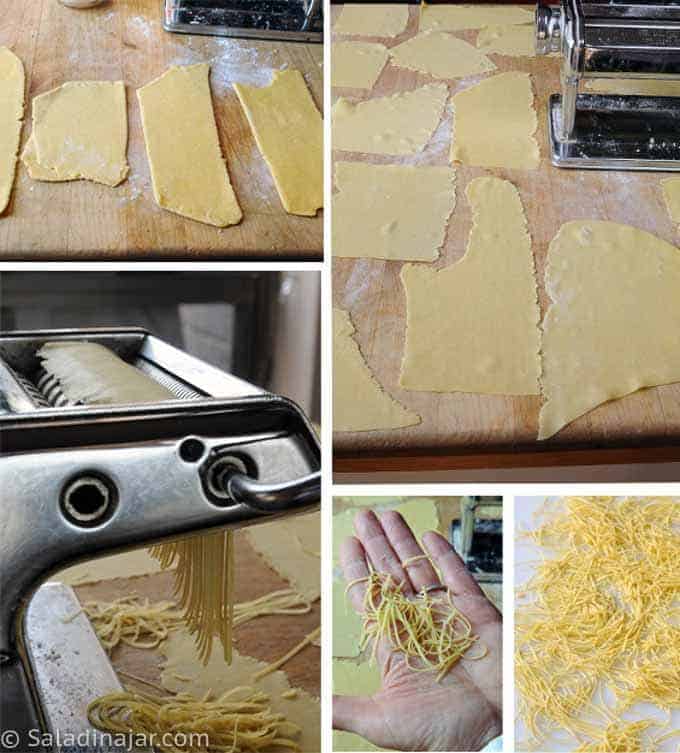
Cook freshly cut noodles immediately. Otherwise, allow the noodles to dry for several hours.
When you’re hanging out in the kitchen
Occasionally, walk over to the noodles and give them a quick toss with your fingers to encourage even drying. When brittle, place noodles in a zippered plastic bag and store them in a cool, dry place for up to a week or freeze them.
How To Cook Your Homemade Noodles
Pour 3 cups of rich chicken or turkey stock into a medium pan and boil over medium heat. Set aside 1 cup of chicken or turkey stock. Drop noodles into boiling broth and cook until tender–about 1 minute if noodles are fresh and undried. If dried, cook longer–5-6 minutes.
Turn off the heat, but do not drain. As the cooked noodles sit in the hot broth, they absorb moisture, and the mixture will thicken slightly. That’s exactly what you want for serving over or next to mashed potatoes.
Add the remaining broth, if necessary, to keep your noodles moist. Like all pasta, they absorb more liquid the longer they marinate in broth.
FAQ About Thin Egg Noodles
Yes. If you have room in your freezer, freezing them ensures that your noodles don’t take on excess moisture from the environment and mold.
Yes. Cook them immediately after cutting. Drying keeps fresh noodles from matting together if you aren’t ready to cook and eat them.
Yes, but they won’t have the same flavor. It’s your chance to be creative.
Parting thoughts: This recipe is not for beginners unless you have a grandma standing over your shoulder. If that’s the case, it’s a wonderful bonding experience for kids and grandkids. Don’t be surprised if they want to eat the raw noodles.
Help at Your Fingertips: For questions or suggestions, email Paula at saladinajar.com. If you need help, I’m happy to troubleshoot via email (faster than leaving a comment). Attach pictures and as many details as possible for the best advice.

Thin Egg Noodles Recipe Like Grandma Used To Make
Rate this recipe
(5 stars if you loved it)
Ingredients
- 1 cup (120 g) all-purpose flour
- pinch of salt
- ¼ teaspoon baking powder
- 3 large (51 g) egg yolks
- ¼ cup (57 g) heavy cream (or whole milk)
- 1 quart (946 g) seasoned chicken or turkey stock
Instructions
Making the noodle dough:
- Add 1 cup (120 g) all-purpose flour to a food processor bowl along with a pinch of salt and 1/4 teaspoon baking powder. Pulse several times to mix.
- Add 3 large (51 g) egg yolks and half of the 1/4 cup (57 g) heavy cream to dry ingredients and process until it mimics the texture of corn meal.
- Gradually drip in the rest of the cream until the mixture is just damp enough to stick together when pressed with your hand. It should not be wet or excessively sticky.
- Knowing when you’ve added the right amount of liquid takes some experience best learned from your mistakes or while watching over Grandma’s shoulder. If necessary, add more flour or cream/milk.
- Use your fingers to press the dough into a ball and remove it from the bowl. Cover and allow to rest for 10+ minutes. Divide the dough into four portions. Smash each section into a flat pancake with the palm of your hand on a floured board. It’s OK to be liberal with the flour.
Rolling out the dough:
- Set the noodle machine thickness to 1 and roll one dough patty between the smooth rollers. Fold over and put through the machine again.
- Repeat process at least 4-5 times until sheet of dough is smooth and shiny. Do this with each patty. Although this sounds time consuming, it goes fast once you get the hang of it.
- Set the thickness of smooth rollers to 2 and roll each sheet through once or twice, tugging slightly on the dough as you pull it through. Keep moving the roller thickness up a notch and repeat the process. I like my noodles as thin as possible, so I go all the way to 6 on my machine, but 5 is also good.
- Along the way, use flour whenever necessary to keep the dough from sticking. As dough strips get thinner, they get longer. Cut in half crosswise as needed.
- When noodles reach desired thinness, lay them out to rest and dry making sure there is no overlap between strips.
- When noodles have dried just enough (again, experience is the best teacher), cut strips as long as you want your noodles. I usually make mine 3-4 inches.
- Feed strips through the fine noodle cutter. Noodles should NOT stick together as they come out of the cutter. If they do, allow the dough to dry longer or dust them with more flour.
- You may cook fresh-cut noodles immediately. Otherwise, allow cut noodles to dry for several hours. Occasionally toss cut noodles with fingers to encourage even drying. When brittle, place in zippered plastic bag and store in a cool, dry place for up to a week or freeze.
Cooking the noodles:
- Pour 1 quart (946 g) seasoned chicken or turkey stock (reserve 1 cup of stock to add later, if needed) into a medium saucepan and boil.
- Drop noodles into boiling broth and cook until tender–about 1 minute if noodles are fresh and undried. If dried, cook longer–5-6 minutes. Turn off the heat. Do not drain.
- As noodles sit in the hot broth, the noodles will absorb moisture and the entire mixture will thicken slightly–perfect for serving over or next to mashed potatoes.
- Add remaining broth if necessary to keep noodles moist. Like all pasta, they absorb more liquid the longer they marinate in broth.
Equipment
Nutrition
All images and text ©️ Paula Rhodes for Salad in a Jar.com


Paula Rhodes, owner
As a retired home economist, I created Saladinajar.com to share my belief that you don’t have to be a chef to find joy in creating homemade food worth sharing. Bread machines (used in an unconventional way), homemade yogurt, and quick microwave recipes are my specialty.